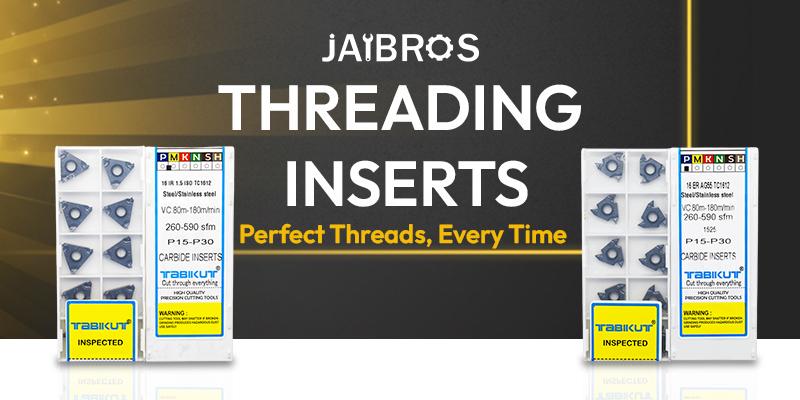Which Threading Insert Is Best for CNC Turning Work in India

Learn how threading inserts improve CNC thread cutting with a clean finish, high accuracy, fast production, and long tool life in modern Indian workshops.
What Is a Threading Insert?
A threading insert is a small carbide cutting tip specially designed for thread machining on CNC lathes.
Unlike old HSS tools, this insert has a fixed profile based on the thread shape. It can be used for internal and external threads and gives a very stable and uniform result.
Modern threading inserts are made from micro-grain carbide, which gives:
-
High wear resistance
-
Strong cutting edge
-
Better heat control
-
Longer tool life in continuous production
Since only the insert is replaceable, workshops save money and avoid downtime.
How a Threading Insert Works in CNC Turning
When the CNC program starts, the machine moves the insert along a precise toolpath.
Every motion—pitch, depth, speed, angle—is controlled by the program. The threading insert removes a thin layer in each pass until the final thread profile is completed.
Advanced CNC threading features include:
-
Constant surface speed (CSS) for smoother threads
-
Infeed angle options (modified flank infeed, radial infeed, flank infeed)
-
Multi-start threads with perfect synchronization
-
Automatic spring passes to improve finish
The insert sits firmly in a tool holder with strong clamping to reduce vibration. This ensures better accuracy and long life.
Types of Threads You Can Make with a Threading Insert
With the proper insert geometry and pitch, CNC operators can make many thread types such as:
1. Metric Threads (ISO)
Very common in mechanical parts and machine components.
2. UN & UNC/UNF Threads
Used widely in machinery, automotive, and export parts.
3. Pipe Threads (BSPT, NPT)
Used in gas lines, hydraulic systems, water fittings, and pressure parts.
4. ACME & Trapezoidal Threads
Used for motion systems like lead screws and jacks.
5. Special Form Threads
Custom profiles made based on drawings.
Choosing the correct threading insert allows the CNC operator to match any industry requirement.
Why Threading Inserts Are Important for CNC Machining
1. High Accuracy in Every Thread
Because the CNC machine repeats the same path, the pitch and profile are always perfect. This is useful when making thousands of parts.
2. Faster Production
Threading inserts support high cutting speeds and quick passes, reducing cycle time.
3. Low Tooling Cost
Only the insert is replaced, not the entire tool. This makes production affordable.
4. Clean Surface Finish
A good threading insert makes threads that fit smoothly without play or tightness.
5. Works on All Metals
Stainless steel, hardened steel, alloy steel, aluminium, cast iron, copper—carbide inserts can handle all with the right grade.
6. Stable in Heavy Jobs
Modern inserts are designed for long production runs and high-load operations.
Where Threading Inserts Are Used?
Threading inserts are common in industries like:
Automotive
Engine parts, axles, bushings, gear components require precise threads.
Hydraulics & Pneumatics
Pipe threads must be leak-proof and accurate.
Aerospace
Critical components with controlled pitch and depth.
Oil & Gas
NPT threads used in pressure and temperature-sensitive systems.
General Engineering
Jigs, fixtures, shafts, custom parts.
Small Job Shops
Daily threading operations for local manufacturing.
Advanced Benefits of Using a High-Quality Threading Insert
1. Heat & Wear Resistance
Coatings like TiN, TiAlN, and multi-layer PVD give better performance at high temperature.
2. More Stability in Deep Threads
Multi-tooth chip breakers help reduce chip load and avoid chip jamming.
3. Perfect Profile Accuracy
Modern inserts are ground to micron-level accuracy, giving perfect thread shape.
4. Less Tool Deflection
Strong clamping prevents movement and protects the thread profile.
5. Longer Tool Life in Stainless Steel
Special grades with cobalt content improve toughness and edge life.
How to Choose the Right Threading Insert
To select the correct threading insert, check these points:
-
Thread type (Metric, UN, NPT, ACME, etc.)
-
Pitch and profile
-
Job material (mild steel, SS, alloy, cast iron)
-
Required finish level
-
Depth of thread
-
Holder stability and insert size
-
Coating grade suitable for long production
This ensures smooth cutting and better tool performance.
Best Practices for Using a Threading Insert
-
Use proper coolant
Helps in chip removal and improves finish.
-
Avoid heavy depth of cut
Take multiple light passes for clean threads.
-
Use spring pass
One or two spring passes remove leftover burrs.
-
Check insert wear regularly
Worn edges create rough or oversize threads.
-
Maintain tool holder alignment
Misalignment causes uneven thread shapes.
-
Keep chips clear
Clean the area to avoid chip accumulation.
Following these practices improves thread quality and increases insert life.
Why CNC Operators Prefer Inserts from Trusted Suppliers
Workshops in India prefer inserts that are:
-
Consistent
-
Long-lasting
-
Easy to clamp
-
Accurate in pitch
-
Good in heat resistance
Platforms like Jaibros.com provide reliable threading inserts with proper carbide grades, making them suitable for all types of CNC turning jobs.
Conclusion
A threading insert is one of the most important tools in CNC turning. It gives high accuracy, better finish, fast production, and longer tool life. Whether you are making automotive parts, pipe fittings, hydraulic systems, or custom components, a good insert ensures that every thread is perfect.
With the right insert, proper cutting parameters, and correct handling, CNC operators can achieve professional results while reducing machining cost.
FAQs
1. What is a threading insert?
It is a small cutting tip used in CNC machines to make threads.
2. Can one insert make all threads?
No, each insert is made for a specific thread size and shape.
3. Which metals can it cut?
It can cut steel, stainless steel, aluminium, and many other metals.
4. When should I change the insert?
Change it when the thread looks rough or the cutting becomes slow.
5. Why do CNC shops use threading inserts?
Because they make clean threads, work fast, and last for a long time.






